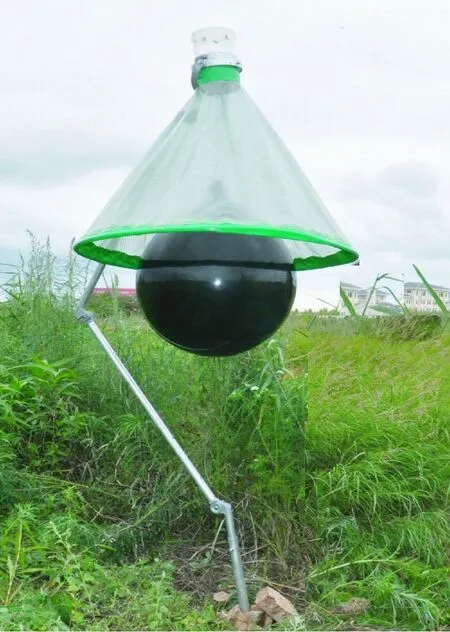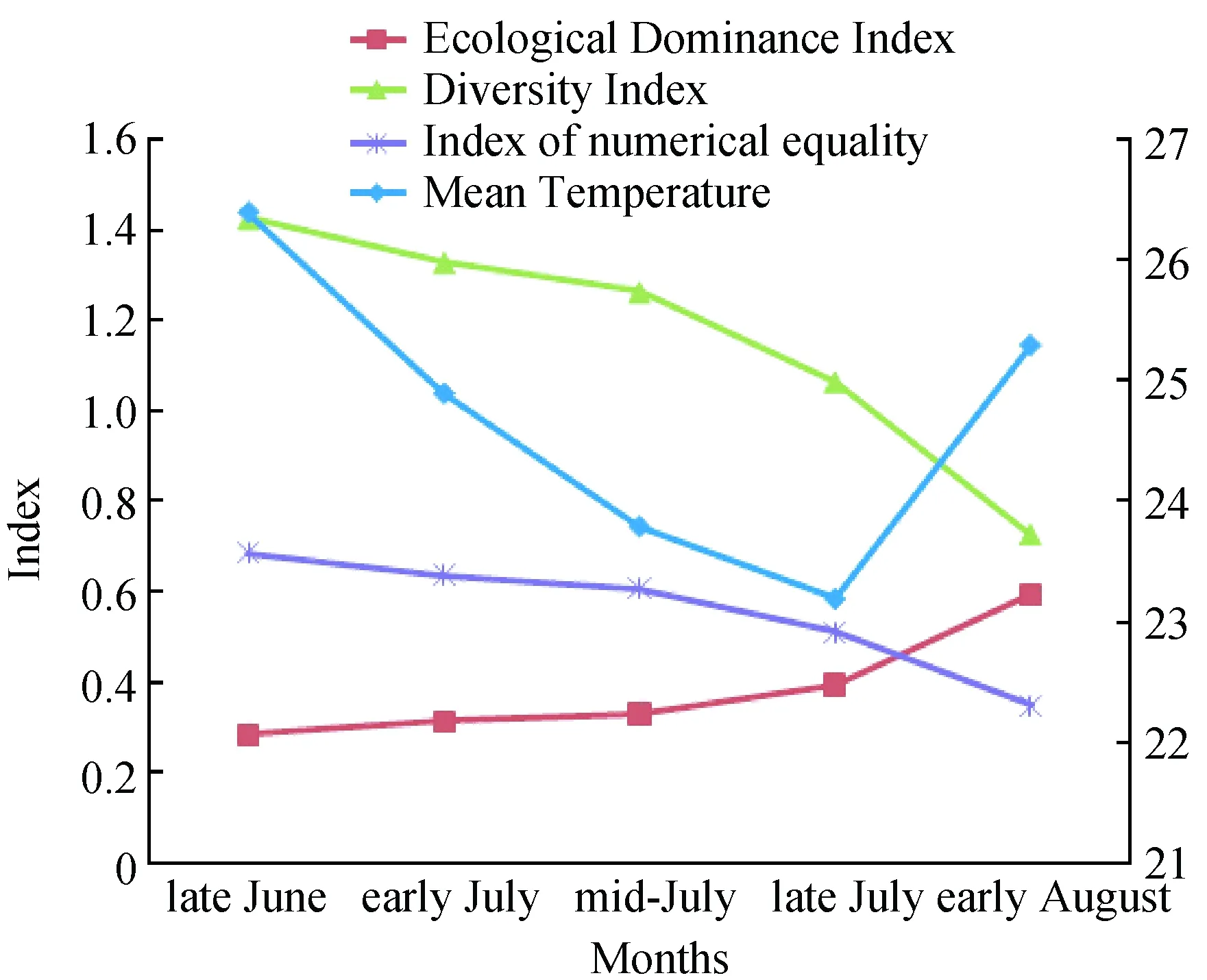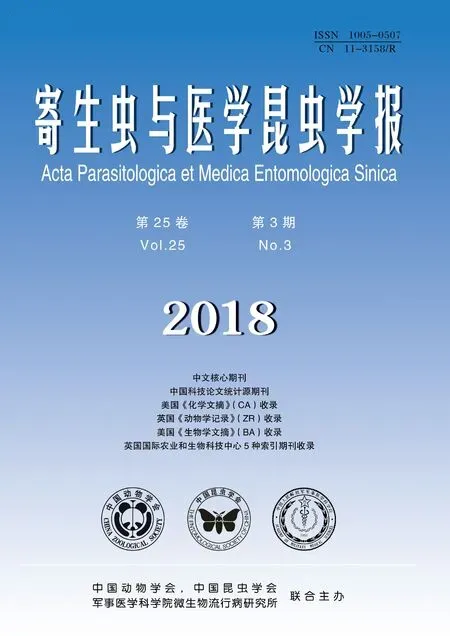SPECIES DIVERSITY AND BITING HABIT OF HORSEFLY IN HEIXIAZI ISLAND OF HEILONGJIANG PROVINCE, CHINA
GUO Xiao-Xia LI Chun-Xiao WANG Gang ZHENG ZhongDONG Yan-De ZHAO Tong-Yan*
(1. State Key Laboratory of Pathogens and Biosecurity, Beijing Key Laboratory of Vector Borne and Natural Infectious Disease; Beijing Institute of Microbiology and Epidemiology, Beijing 100071, China; 2. Center for Disease Control and Prevention of Former Xinjiang Command, Urumqi 830011, China)
Abstract Heixiazi Island locates in the easternmost end along the Sino-Russian border of Fuyuan County, Heilongjiang Province. Adult horseflies take blood meals from various mammals including humans and are known to cause multiple zoonoses. There was still no information nowadays about the distributions and seasonal activities of horseflies in Heixiazi Island, and no sufficient controlling measures to reduce their harms to livestock and humans. The species diversity and seasonal activities of horseflies on Heixiazi Island were investigated during June to August of 2012 and 2013 with traps (Horsefly Trap, Alcoche-Hygiene, Holand) every 500 m apart along the wet meadows of forest edge, river banks and villages. A total of 5 941 specimens including 9 species of five genera were identified. Tabanus griseinus was the dominant species accounted for 40.57%, and followed by Atylotus miser accounted for 35.15%. The species diversity index was higher in late July, and then declined gradually over the successive two months. Hybomitra distinguenda prefer to breed in the wet meadows alone the forest edge, while A. miser and T. griseinus are the dominant species near the human settlements. The population structure of horsefly′s community appeared to be relatively stable in late June in respect to species diversity obtained by trap sampling. The species dominance index was relatively higher with several dominant species in early August. The results indicated that the high-risk period for horsefly-borne diseases in Heixiazi Island area is from mid-June to all July of a year.
Key words Heixiazi Island; Tabanid; Species diversity
Tabanidae insects are considered with great medical and veterinary significance for their transmission of diseases and the stresses, or secondary infections such as anemia, allergic responses due to direct bites of horseflies (Chvala, 1972).
Heixiazi Island is located at the easternmost end in the Sino-Russian border of Fuyuan County, Heilongjiang Province. The island, about 40 meters above sea level, lies within the triangle area formed by the convergence of Wusuli and Heilongjiang rivers and Fuyuan Canal. The flat ground, wetland meadows and countless streams in the Island provide various breeding habitats for insects. Horseflies presented a typical fauna in the Island according to the previous findings in Changbai Mountain (Zhang, 1999).
Numerous studies on the distributions and seasonality of Tabanid species had been performed in China (Liuetal., 2002, Wangetal., 2006), there was still no information of horsefly species on Heixiazi Island and therefore no sufficient control method to reduce their impacts on livestock and humans. Documenting of horsefly diversity and seasonal activity patterns is a fundamental step to develop the rational control strategies and quantify the risk of pathogen transmission via these vectors (Krcmar, 1999, 2005). The first data on the distribution and species diversity of horseflies on Heixiazi Island has been given in present paper.
1 Methods
1.1 Study site
Field trial was conducted on Heixiazi Island (N134°24’,E48°17’). The Island located in a continental climate zone with about 600 mm annual rainfall and 20.2° C mean temperature and 60% relative humidity respectively.
1.2 Collection
Horseflies were sampled with traps(Horsefly Trap, Alcoche-Hygiene, Holand)(Fig. 1) which were placed every 500 m along the sample sites where wet meadows were along the forest edge, river banks and human settlements were previously selected. The sampling was conducted from June to August of 2012 and 2013, respectively. Traps were operated continually from 800 to 1 800 every sampling day. Trapped horsefly specimens were recorded after identification following the taxonomic keys (Xuetal., 2013).
1.3 Data analyses
Pielou′s (1949) formula,J=H′/lnS, whereJis the index of the degree of homogeneity andSis the number of species, was used to calculate the index of the numerical equality between species in different months and habitats(Simpson, 1949).
The Berger-Parker Dominance Index, whereD=Nmax/N,Nmaxis the number of the dominant species andNthe total number of all specimens, was used to provide an index of overall dominance. We used the standard criteria to rank the relative dominance of various species; dominant species were those for whichD≥ 0.1, abundant species were those whereDwas in the range 0.05 ≤D<0.1, common species were those for whichD= 0.01~0.05, occasional species were those for whichD=0.001~0.01 and rare species were those for whichD< 0.001(Simpson, 1949).

Fig.1 Horsefly Trap was used to sample horseflies in Heixiazi Island
2 Results
2.1 Species composition
A total of 5 941 tabanids specimens were collected and identified belonging to 8 species of 5 genera (Hybomitra,Tabanus,Atylotus,ChrysopsandHaematopota) of 2 subfamilies. All the 8 species were found in all the 3 habitat types (Tab. 1). The most abundant species wasT.griseinus(Xuetal., 2013) accounted for 40.57%, and followed byA.miseraccounted for 35.15%.Hy.distinguendaandT.pleskeiwere the secondly most abundant species accounted for 13.16% and 8.95%, respectively. The other 4 species were relatively rare, accounted less than 1% of the total samples. Species dominance varied with sampling locations (Tab. 1).Hy.distinguendawas the dominant species in wet meadows on the forest edge with a dominance index of 0.4874, followed byA.miser.A.miserandT.griseinuswere the most dominant species in human settlements with dominance indices 0.4981 and 0.3293,respectively. River habitat had the highest species richness, whereHy.distinguenda,A.miserandT.griseinuswere the dominant species.

Tab.1 Dominance index (D) and relative richness of Tabanids in three habitats of Heixiazi Island
2.2 Species diversity in different months
Dominance index (D) and richness of tabanids captured in different months on Heixiazi Island were shown in Tab. 2. TheH',JandCparameters were calculated, and thereby to estimate the community composition and distribution of horseflies in different months (Fig.2).A.miserandT.griseinuswere the locally dominant species. Species′richness varied month by month, peaked during late June to mid-July but declined during late July to early August. Overall, both species richness and diversity were relatively low. The species diversity index and quantity of each species decreased gradually over the successive 2 months.

Fig.2 Horseflies species diversity, evenness and ecological dominance under different average temperature and dominant periods on Heixiazi Island

Tab.2 Dominance index (D) and abundance of tabanids in different months on Heixiazi Island.
2.3 Species diversity and seasonal abundance
T.griseinusandA.miserwere the locally dominant species followed byHy.distinguenda. Seasonal variation of the species′dominance index is shown in Fig. 2. Among them, theDindex ofT.griseinusincreased during the sampling period from late June to peak in early August.A.miseremerged relatively rare in late June, increased and kept stable in July and then declined markedly in late August.Hy.distinguendapeaked in late June then decreased gradually to their lowest level in early August (Fig.3).

Fig.3 The species dominance index varied during occurrence period
T.griseinusandA.misercomprised the majority of captured specimens being considered as the locally dominant species. Species diversity (Shannon-Wiener index) is negatively correlated with the abundance ofT.griseinusand vice versa (Fig. 4), which implys that monthly trends of species diversity are primarily deciduous to the monthly abundance ofT.griseinus.

Fig.4 Monthly variation in species diversity and species dominance of horseflies in Heixiazi Island
3 Discussion
Horseflies feed on humans and livestock thereby spreading equine infectious anemia, tularemia, anthrax and other animal diseases. Aproximately 458 species of tabanids have been documented in China (Xuetal., 1991; 2013), of which 60 species in 5 genera have been recorded in Heilongjiang Province’s (Liuetal., 1998). The present study has extended the knowledge about the diversity of tabanids species presented in Heixiazi Island with the first data of species diversity and seasonal abundance of Tabanid species.
T.griseinusandA.miserwere apparent dominant species, followed byHy.distinguendaandT.pleskei. Heixiazi Island has large areas of wetlands and marshes, which provide favourable breeding habitats for these species (Tab. 1).Hy.distinguendais the dominant species of wet meadows on the forest edges, whileA.miserandT.griseinusare the dominant species near human settlements.Amiseris also the dominant species in North China plains, which had been proved a competent vector of trypanosomiasis in camels in northwest China (Shietal., 1996). Species diversity was relatively high in riverside habitat whereHy.distinguenda,A.miserandT.griseinushave beenn shown as the dominant species.
The results of present study indicated thatHy.distinguendafrequently active at the end of June,A.miserin early July,A.miserandT.griseinusin mid-late July andT.griseinuswas only recorded in August. The highest abundance of tabanids has been found during the end of June when the highest temperature and the lowest relative humidity occurs.
Monthly variation of species richness also shows that the species diversity index is relatively high in late June (Fig. 2), indicating that this month is the most informative sampling period to investigate the species diversity of horseflies. Species diversity gradually decreased over the successive 2 months. The results also consented with the index of evenness which appeared relatively high in late June, indicating that the community structure is relatively stable with relatively low species dominance index. By early August, dominant species are more apparent with relatively high dominance index.
Our results provide important information that can be used to develop more effective control strategies for horseflies and determine the most appropriate times for implementing control strategies, when related to livestock and human activities.

